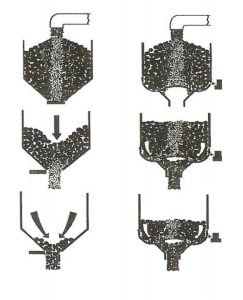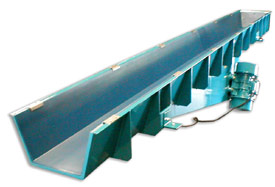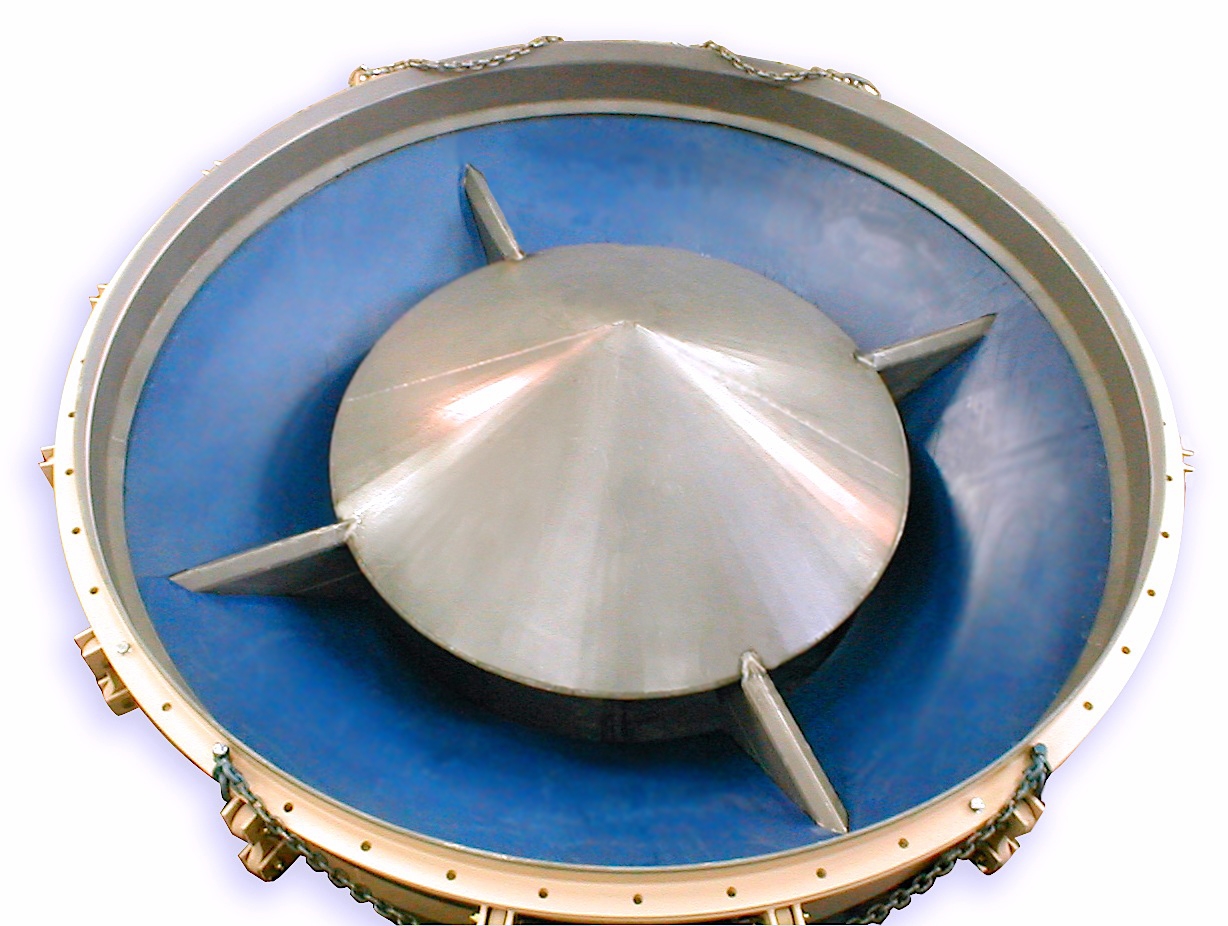When considering the use of a silo discharge system to help convey materials, it is crucial to assess the specific requirements of the materials being stored, the operational goals and the overall system compatibility.

Phone: 973-256-7410 Email: info@vibrascrew.com

When considering the use of a silo discharge system to help convey materials, it is crucial to assess the specific requirements of the materials being stored, the operational goals and the overall system compatibility.

Over our 65 plus years of making Bin Activators we have had the opportunity to work on projects that require special designed Bin Activators for a wide range of industries.
The normal material of construction of a Bin Activator (material contact parts) is carbon steel, 304 or 316 stainless steel, depending the customer’s needs. Special applications over the years required aluminum, titanium and Hastelloy with the occasional abrasion resistant liners made from T-1 AR steel, ceramic tiles (like the space shuttle), Tivar™ UHMW-PE and we even made a fiberglass lined Bin Activator.
In 1978 a customer who handles Chlorinated Dry Bleaches asked Vibra Screw to build eight, 5 ft diameter Bin Activators made out of Inconel 600 which we did. These units have been running without issues for 48 years, but even Inconel is not completely unaffected by the corrosive powder. Time took its toll on the units and they needed replacing.
The photo shows the first two replacement 5 ft Vibra Screw Bin Activators, made from Inconel 600, with non-Inconel parts epoxy coated. As we say “Vibra Screw products are Built To Last”.


Curbs segregation of bulk-stored mixes
Recent field experience indicates that segregation of dry mixtures in bulk storage can be eliminated by proper application of vibration to the material in storage. As a result, food processors are adding vibrating bin activators to the bottom of hoppers and bins not only to induce flow, but also to eliminate segregation.
An Indiana miller, for example, cut deviations in composition of a bakery premix by one half. Included in the premix are flour, salt. sugar, soda and cornstarch.
Although these ingredients differ widely in density, particle size and flow characteristics, vibration helps keep composition at discharge very close to that at the inlet.
Less segregation, better quality
Eliminating segregation in dry mixes brings three principal benefits. First, better product quality can be maintained on a consistent basis. Second, downtime and lost production due to rejected batches or remixes, can be reduced. And finally, engineering management gains more flexibility in plant design and operation. Larger quantities can be bulk-stored because the risk of segregation no longer limits storage capacity. It is also possible to mix first and store later in instances where the risk of segregation might previously have ruled out this option. Such added flexibility can lead to improved production and important cost savings.
 In the static bin (left sequence) loaded with material of non-uniform particle size. A pipe forms down the center of the outlet. The vibration-assisted bin (right sequence) has a baffle over the outlets.
In the static bin (left sequence) loaded with material of non-uniform particle size. A pipe forms down the center of the outlet. The vibration-assisted bin (right sequence) has a baffle over the outlets.How vibration cuts segregation
Picture what happens when you pour a mixture of stone and sand on the ground. A rough cone forms, with stones mainly around the outside and sand mainly in the center. The stones tend to roll down the surface of the cone as it is formed, while the sand sifts down closer to the center. Segregation has taken place.
If, as usually happens in a conventional storage bin,
material discharges from the center of the bin first, finer material would emerge first and coarse material last.
The same basic thing happens in mixtures of dry ingredients having differing physical characteristics. Differences in particle size are the principle contributors to segregation. Differing flow characteristics and density may also influence the situation; however, the combination of a vibrating bin bottom with a built-in baffle over the final outlet substantially reduces the segregation problem.
Vibration keeps the material mobile and free-flowing, particularly at points of potential bridging, and the baffle directly over the outlet prevents material from emptying down a pipe in the middle first, and then off the walls as often occurs in static bins.
Because of the baffle. the pipe never gets a chance to form. Instead, the material draws evenly across the cross section. Moreover, the final discharge is a combination of materials from the center and those from nearer the walls. So even if there were segregation from the center out, there is re-mixing just before discharge. This flow pattern is called mass flow, or first-in, first-out flow.
Mass flow of bulk materials from a bin has been demonstrated in experiments in which layers of different-colored materials are loaded into a bin equipped with a bin activator, developed by Vibra Screw Inc.
Achievement of true mass flow from a bin eliminates risk of dead areas, spoilage and contamination among products processed on the same equipment.
Case in point
The Indiana miller’s experience underscores most of these points. The plant produces dough for dinner rolls and sweet rolls. The basic operation is to blend the dry ingredients into a dry premix. It is stored in a pre-mix bin, and discharged at a controlled rate to a scale hopper, then to a mixer where wet ingredients are added and the dough is developed. The bin is 7-feet- diameter by 15-feet-high and holds more than 10,000
pounds.
Originally, all feeding and dispensing of dry ingredients were by gravity. But a disparity in physical properties of the dry ingredients led to segregation within the storage bin. Densities ranged from 38 to 75 pounds-per-cubic-foot. and particle sizes from 30 to 400 mesh. As a whole. the mixture has a density of 55 pounds-per-cubic-foot and a moisture content of 5 percent.
To minimize segregation, a 7-foot-diameter bin activator was installed on the premix bin.

Closer control also was maintained over the quantity of material stored in the bin. This kept retention time of material in the bin close to 50 minutes. The bin activator mounts to the bottom of the bin in place of the standard bin bottom. Special hangers isolate it vibrationally from the bin. A patented gyrator on the bin activator generates vibratory forces up to 6,000 pounds to vibrate the entire bin bottom and its contents, but not the bin itself. In addition, an integral dished baffle mounted horizontally in the bin activator above the outlet vibrates to induce mass flow from the bin. It also prevents packing at the outlet due to static head loads.
Result of the installation was immediate reduction in segregation. This company measures composition of the premix by monitoring pH of the dough after blending.
Too high a pH means excess alkaline ingredients such as soda. A low pH indicates that level of acidic ingredients, such as salt, is running too high.
With the activator generating controlled vibration into the premix and inducing true mass flow in the bin. the number of samples falling within specifications rose from 68 percent to 78 percent. Moreover, deviations one percent below specifications dropped from 22 percent to 10 percent, deviations two percent below stayed constant at five percent, and deviations on the high side increased from three percent to only five percent.
In addition to improved quality control, the company reports that eliminating segregation improved line machinability of the product as it moves through the process. Based on this experience, it has installed another activator on a second process line.


Over our 65 plus years of making Bin Activators we have had the opportunity to work on projects that require special designed Bin Activators for a wide range of industries.
The normal material of construction of a Bin Activator (material contact parts) is carbon steel, 304 or 316 stainless steel, depending the customer’s needs. Special applications over the years required aluminum, titanium and Hastelloy with the occasional abrasion resistant liners made from T-1 AR steel, ceramic tiles (like the space shuttle), Tivar™ UHMW-PE and we even made a fiberglass lined Bin Activator.
In 1978 a customer who handles Chlorinated Dry Bleaches asked Vibra Screw to build eight, 5 ft diameter Bin Activators made out of Inconel 600 which we did. These units have been running without issues for 48 years, but even Inconel is not completely unaffected by the corrosive powder. Time took its toll on the units and they needed replacing.
The photo shows the first two replacement 5 ft Vibra Screw Bin Activators, made from Inconel 600, with non-Inconel parts epoxy coated. As we say “Vibra Screw products are Built To Last”.

A line of dependable economical Bin Dischargers is available to system suppliers and OEM’s from Vibra Screw Inc. Based on over 50 years of bin discharge experience, those units are ruggedly built, simple to install and come with Vibra Screw’s unconditional performance guarantee.The Bin Discharger’s simple, compact design incorporates all of the important features customers have come to expect from Vibra Screw such as a leak proof molded sleeve, heavy duty suspension system, and long life vibrator. Designed to provide on demand flow from bins up to 20′ in diameter, standard Vibra Screw Bin Dischargers are available for quick delivery in both carbon steel and stainless steel.

Totowa, NJ: Vibra Screw Inc., a leader in bulk solids processing equipment, announces the availability of its vibrating equipment line with TIVAR® ultra high molecular weight liners. TIVAR® is used extensively as a wear and flow promoting material offering high impact strength, superior abrasion resistance and a slick contact surface. It meets FDA, USDA and 3-A food and pharmaceutical guidelines. TIVAR® can be used to line the company’s Bin activators, Vibrating Bins and Vibrating Feeders, reducing wear and corrosion and promoting flow of sticky materials. Installation is through simple fasteners making replacement fast and easy. TIVAR® will economically replace previously used Abrasion Resistant Steel and Stainless Steel liners. Vibra Screw manufactures high quality equipment to store, discharge, meter, convey, size and blend bulk materials. The company’s product line includes Bulk Bag Unloaders and Fillers, Volumetric and Gravimetric Feeders, Bin Activators, Vibrating Bins, Vibrating Feeders and Blenders.

Totowa, NJ: Vibra Screw, Inc., the industry leader in solids processing and solids handling solutions, now offers a free brochure describing its Vibrating Bins. These units are self contained, ready to operate hoppers designed to provide positive discharge of a variety of bulk materials. The full color piece includes photographs, machine specs and diagrams. Vibra Screw’s product line includes bin activators, bulk bag unloaders and fillers, volumetric and gravimetric feeders, live bottom bins, vibrating feeders and blenders. All Vibra Screw equipment is unconditionally guaranteed to perform in the service for which it was sold or they will refund your money. Period.

TOTOWA, NJ — Vibra Screw, Inc., a leader in solids processing and solids handling solutions, has expanded and its line of Bin Activators, with a new vibrator assembly, sanitary design, and variable rates leading the featured improvements. Smaller units 6 ft. and under now come standard with a vibrator that is more economical while offering simplified vibration adjustment. New sanitary features include an open design without cross members for complete and unhindered self-cleaning of material. In addition, a new special baffle arrangement allows rate adjustment without the need for a separate feeder.Vibra Screw’s line of Bin Activators now also includes an OEM line of Bin Dischargers that provide a simplified and more economical alternative to standard dished head bin activators for most bulk material applications.As with all Vibra Screw equipment, the Bin Activators and Bin Dischargers are unconditionally guaranteed to perform in the service for which they are sold. With a staff of experienced and talented engineers, technicians and crafts people, Vibra Screw manufactures high quality equipment to store, discharge, meter, convey, size and blend solid materials. The company’s comprehensive product range includes bulk bag unloaders and fillers, volumetric feeders, bin activators, vibrating feeder/conveyors, loss-in-weight feeders, storage pile activators, live bottom bins, live bins, continuous blenders, screeners, controls, and turnkey systems.